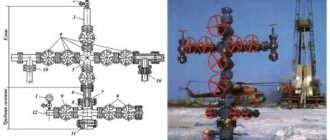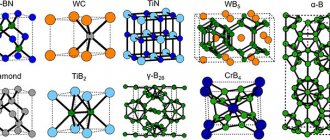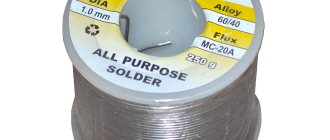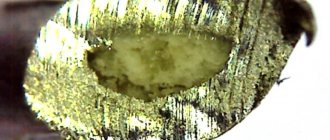Composition and purpose of molding and core mixtures
Molding sands are used to make molds, and core sands are used to make cores. They consist of quartz sand, refractory clay and various additives.
The properties of the molding materials used to make mixtures play a big role in obtaining high-quality castings. And the composition of (core and molding) mixtures and the requirements for them in terms of ductility, gas permeability, strength, pliability and non-stick properties depend on the weight of the castings and the composition of the metal being poured.
The main materials for making molding sands are used sand (burnt or recycled) and fresh materials, which serve only to replace sand grains that have turned into dust and to replenish the binding capacity of the clay.
Based on the method of application, molding sands are divided into facing, filling and single. The front layer of the mold, which is in direct contact with the liquid metal, is made from a mixture of high strength and is prepared more carefully. This mixture is called facing
.It is made using 30-50% materials.
The rest of the mold is made from a different mixture of lower quality and cheaper. This mixture is called filler
. It consists of a circulating mixture with the addition of 1-3% sand to restore the gas permeability of the clay and to increase strength. In mass production, Molds are usually made from a homogeneous mixture called uniform. It consists of 90-95% reverse mixture with the addition of sand and clay to refresh it.
The compositions of the molding sand are different for molds that are dried before pouring and for molds that are poured wet (Table 1). When making molds and then drying them, molding mixtures with 10 - 20% clay are used. For wet molding, molding mixtures containing from 2 to 10% clay are used.
Table 1 - Ratio of starting materials in molding sands
| Type of casting | Composition and weight, % | |||
| reverse mixture | fresh materials: sand and clay | coal | fuel oil | |
| for wet casting | ||||
| Cast iron | 75-90 | Rest | 2-3 | — |
| Steel | 50-75 | -«- | — | — |
| Bronze | -«- | — | 1-1,5 | |
| Brass | 60-80 | -«- | — | -«- |
| Aluminum | -«- | — | — | |
| for dry casting | ||||
| Cast iron | 40-60 | Rest | — | — |
| Steel | 50-75 | -«- | — | — |
| Bronze | 60-70 | -«- | — | — |
The basis of the molding mixture is quartz sand, in which the silica content for steel casting must be at least 97%, for cast iron - 90-95% and non-ferrous - 80-90%. Depending on the silica content, clay component and harmful impurities, all sands are divided into quartz (K) clay. Quartz sands include sands containing at least 90-97% SiO2 and no more than 2% clay component (GOST 2138-56). Sands containing up to 50% clay substances are classified as clayey. Clay sands are divided into several classes: lean T (from 2 to 10% clay), semi-fat P (from 10 to 20% clay), fatty F (from 20 to 30% clay), very fatty OZH (from 30 to 50% clay) .
Depending on the size and shape of quartz grains, sands are divided into several groups. For example, medium sand, classified as group 02 according to GOST 2138-56, consists of grains measuring 0.315; 0.2 and 0.16 mm. For steel casting forms, quartz medium and fine sands K02A, K016A are used. For cast iron and non-ferrous castings -
— bold sands P02A, P01bA. Grain sizes are 0.3150.2 and 0.16 im.
The clay category includes sands containing over 50% clay component. They are rocks consisting of fine particles of hydrous aluminosilicates.
Refractory clays give molding sands plasticity when wet and increased strength and gas permeability when dry.
Core mixtures consist mainly of quartz sand with a minimal content of clay components and binding materials.
When pouring the mold with metal, the rods are in less favorable conditions than the mold. In most cases, the rods are surrounded on almost all sides (except for signs) by molten metal. Therefore, the material of the rods must have greater gas permeability, strength, pliability, and non-stick properties than the mold material. In addition, the rods should have a possibly lower gas content, should not be hygroscopic and should be easily knocked out of the hardened casting.
Based on their composition, core mixtures are divided into sand-clay and sand-oil. Sand-clay mixtures containing 96-97% quartz sand and 3-4% clay are used mainly in the manufacture of large rods on frames. Sand-oil mixtures consist of quartz sand (100%) with the addition (1.5-3% of the total weight) of binders (fasteners) (Table 2).
Table 2 - Ratio of starting materials in core mixtures
| Composition in weight. % | Binding materials in % by weight of the grain part of the mixture | |
| Quartz sand | Clay | |
| For iron casting | ||
| — | Vegetable oil, drying oil 0.8-1.6 | |
| Rematol 4 GU 2-4 | ||
| 96-97 | 3-4 | Peat or wood pitch |
| For steel casting | ||
| — | Rematol 1.2-3 | |
| Rematol 4 GU 1.5-3 | ||
| 96-97 | 3-4 | Peat or wood pitch |
Sawdust, coal dust and other additives are added to molding and core mixtures to increase gas permeability and plasticity. Drying oil, vegetable oils, wood or peat pitch, and sulfite liquor stillage are used as binding materials. These substances increase the strength of molding and core mixtures.
In recent years, quick-hardening mixtures with the addition of liquid glass have begun to be widely used (Table 3). Molds and cores made from quick-hardening mixtures with liquid glass provide a dramatic improvement in the surface quality of castings and eliminate burnt marks.
Depending on the requirements for molding sands, various grades of liquid glass are used for their production (GOST 8264-56). Liquid glass grade A is used if the mixture must retain its plastic properties for a long time; grade B - when rapid hardening of the mixture is necessary. In all other cases, liquid glass of grade B is used.
Table 3 - Ratio of starting materials in quick-hardening mixtures
| Blend number | Composition in weight. % | ||||
| Quartz sand | Spent mixture | Molding clay | Sodium hydroxide | Liquid glass | Fuel oil |
| 95-97 | — | 3-5 | 0,5-1,5 4,5-6,0 | 0,5 | |
| 50-70 | 30-50 | — | |||
| — | — |
For medium-weight castings, dry fine-grained quartz sand of the KO16A, KO16B, KO1A grades is used, and for small castings - medium-grained grade K025A (GOST 2138-56).
Molding clay (GOST 3226-65) is dried, crushed, ground and sifted through a sieve with 0.5-1mm mesh. The spent mixture is introduced to increase the strength of the quick-hardening mixture in the wet state,
Caustic soda (10-20% NaO2 solution) increases the strength of the mixture in the dry state and preserves the plastic properties of the mixtures for a long time.
To facilitate knocking out rods from castings, up to 3% bauxite, ground to 0.5-1.0 mm, is added to the mixture. To reduce the adhesion of the mixture to models and core boxes, up to 0.5% fuel oil is added to its composition.
When preparing quick-hardening mixtures, sand is first loaded into the runners, then the spent mixture, ground clay and bauxite. The dry materials are mixed for 2 minutes, after which caustic soda, liquid glass and fuel oil are introduced successively. The duration is controlled when the specified wet strength of the mixture is achieved. The longer the mixing, the higher the wet strength and the lower the strength of the mixture after hardening. Excessive mixing time can cause the mixture to completely lose its plastic properties.
When molding, models, model plates, models of the gating system, vents and profits are wiped with kerosene.
The finished mold is purged with carbon dioxide CO2. Carbon dioxide, interacting with liquid glass, forms films of silicic acid gel, which help strengthen the mixtures.
If the mold is made from mixture 3 (Table 3), then it is purged with CO2 before removing the model from the mold. The supply of carbon dioxide is carried out through holes with a diameter of 2-3 mm in the hollow model. Purge duration is 15-20 seconds. If the mold is made from mixture 1 or 2, then it is purged with CO2 after removing the model from the mold.
mtomd.info
Natural and artificial materials are used to prepare mixtures. Sand is the main component of molding and core mixtures. Typically quartz or zircon silica sand is used. Clay is a binder that provides strength and plasticity and has thermal stability. Bentonite or kaolin clays are widely used.
To prevent burning and improve the cleanliness of the surface of castings, non-stick materials are used: for raw molds - dust; for dry forms - paints.
The following are used as dusts: for cast iron castings – a mixture of magnesium oxide, charcoal, powdered graphite; for steel castings - a mixture of magnesium oxide and refractory clay, dusted quartz. Non-stick paints are aqueous suspensions of these materials with the addition of binders.
Properties of molding and core mixtures
- strength - the ability of the mixture to ensure preservation of its shape without destruction during manufacture and operation;
- surface strength (frayability) – resistance to the abrasive action of a metal jet during pouring;
- plasticity - the ability to perceive the outline of a model and maintain the resulting shape;
- compliance - the ability of the mixture to shrink in volume under the influence of shrinkage of the alloy;
- fluidity - the ability of the mixture to flow around the model during molding, filling the cavity of the core box;
- thermochemical stability or non-sticking - the ability to withstand high temperatures of the alloy without melting or chemical interaction with it;
- non-hygroscopicity - the ability, after drying, not to absorb moisture from the air;
- durability – the ability to retain its properties after repeated use.
According to the nature of use, they are distinguished: facing, filling and single mixtures.
Facing - used to make the working layer of the mold. Contains an increased amount of initial molding materials and has high physical and mechanical properties.
Filler – used to fill the mold after applying the facing mixture to the model. It is prepared by processing the recycled mixture with a small amount of initial molding materials.
Finishing and filling mixtures are necessary for the production of large and complex castings.
Single – used simultaneously as a facing and a filler. Used in machine molding and on automatic lines in serial and mass production. Made from the most refractory sands and clays with the highest cohesiveness to ensure durability.
Preparation of molding sand
First, sand, clay and other raw materials are prepared. The sand is dried and sifted. The clay is dried, crushed, ground in ball mills or runners and sifted. Coal powder is prepared in the same way.
Then the circulating mixture is prepared. After being knocked out of the flasks, the recycled mixture is kneaded on smooth rollers, cleaned of metal particles in a magnetic separator and sifted.
Preparation of the molding sand includes several operations: mixing the mixture components, moistening and loosening.
Mixing is carried out in runner mixers with vertical or horizontal rollers. Sand, clay, water and other components are loaded using a dispenser, mixing is carried out under the action of rollers and plows that feed the mixture under the rollers.
The finished mixture is kept in settling bunkers for 2…5 hours to distribute moisture and form water shells around clay particles.
The finished mixture is loosened in special devices and served for molding.
Preparation of core mixture
Core mixtures correspond to the conditions of the technological process for manufacturing foundry cores, which are subject to thermal and mechanical stress. They must have higher fire resistance, gas permeability, pliability, and be easily knocked out of the casting.
Refractoriness of a mixture is the ability of the mixture and shape to resist stretching or melting under the influence of the temperature of the molten metal.
Gas permeability of a mixture is the ability of a mixture to pass gases through itself (sand helps to increase it).
Depending on the method of manufacturing the rods, the mixtures are divided into: mixtures with the rods hardening by heat drying in a heated equipment; liquid self-hardening; liquid cold-hardening mixtures based on synthetic resins; liquid glass mixtures cured with carbon dioxide.
Preparation of core mixtures is carried out by mixing the components for 5...12 minutes, followed by standing in bins.
In modern foundries, the production of mixtures is carried out in automatic areas.










